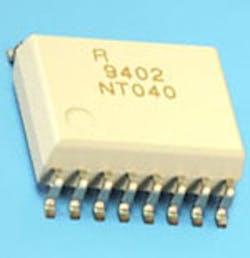Figure 1
Dusseldorf, Germany: When a fault (short circuit) occurs in an IGBT connected to a optocoupler, the collector-emitter voltage of the IGBT rises and may damage the device. To that end, Renesas developed the PS9402 IGBT drive optocoupler, which integrates an insulated gate bipolar transistor (IGBT) protection function.
Simply put, the protection function detects a rise in collector-emitter voltage and turns off the IGBT. There’s also a soft turn-off function that suppresses the generation of noise when the IGBT is turned off. A fault signal is output to the MCU to indicate that an abnormal shut-off has occurred, and an auto-reset function performs recovery automatically once a specified time (minimum 5 µs) has elapsed after detecting the fault.
Inverter circuits typically contain a high-voltage circuit block incorporating power devices (e.g., IGBTs or MOSFETs), and a control circuit block employing various components (e.g., a microcontroller). Optocouplers designed for use with IGBTs or MOSFETs electrically isolate the two circuit blocks.
An IGBT drive coupler is typically used for the drive control of an IGBT, but a protection circuit is also needed to safeguard the IGBT. This tends to complicate the overall system design. Renesas claims the PS9402 avoids this by integrating the protection circuit.
The optocoupler comprises a gallium-aluminium-arsenide (GaAlAs) LED, a photodetector IC, and the IGBT protection circuit. It drives IGBTs used in inverter devices for purposes such as motor control. Moreover, it enables IGBT direct drive up to 1200V and 100A. Other key features include high-speed and low-power operation, plus an integrated active Miller clamp circuit to prevent IGBT malfunctions.
About the Author
Sally Ward-Foxton
Sally Ward-Foxton is Associate Editor of Electronic Design Europe. Her beat covers all areas of the European electronics industry, but she has a particular interest in wireless communications and displays technology. She was previously Features Editor of Components in Electronics magazine and has also worked as a PR Account Director. Based in London, Sally holds a Masters' Degree in Electrical and Electronic Engineering from the University of Cambridge, UK.
